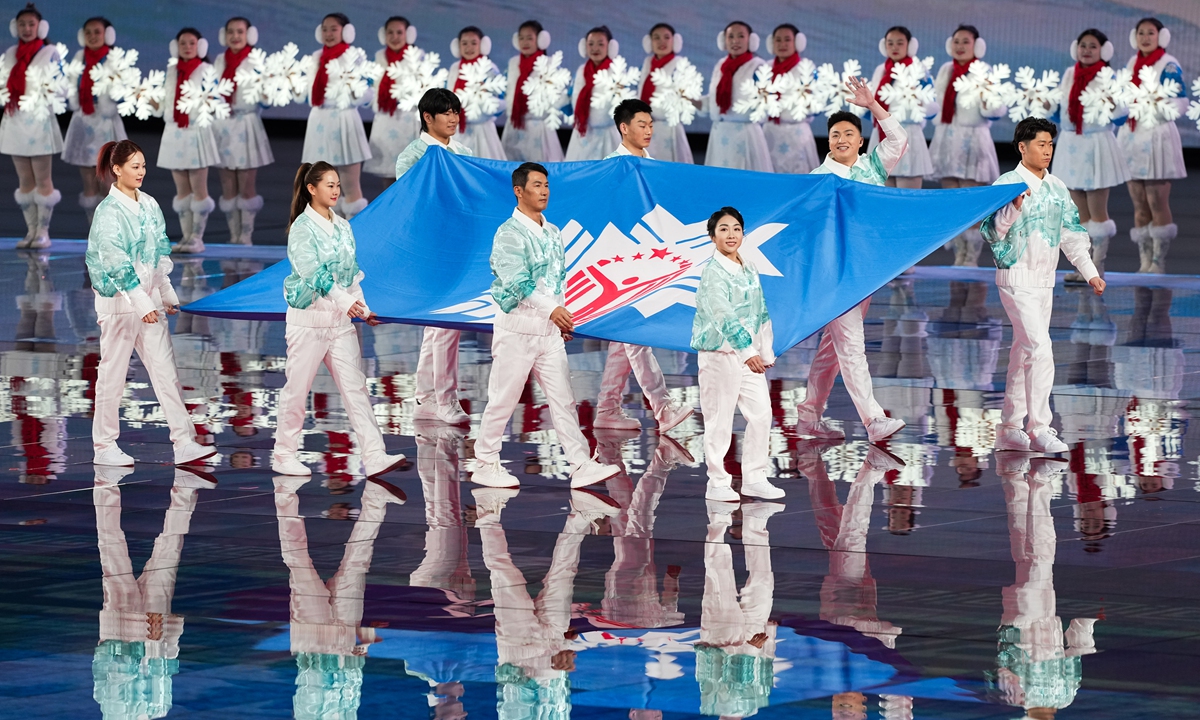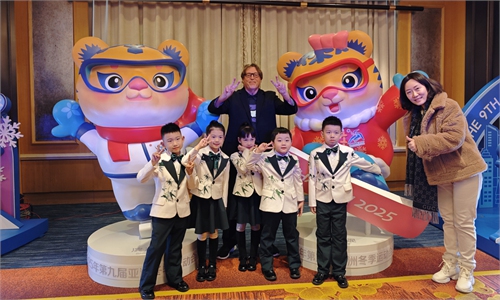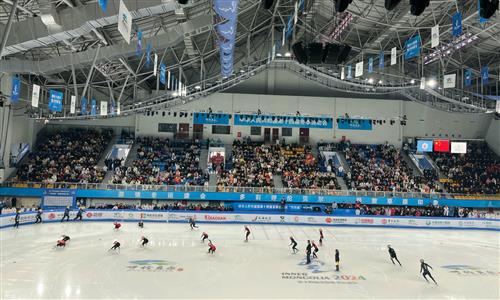SPORT / MISCELLANY
Winter Games officially opens
Event largest national sports meet after Beijing 2022

Photo: VCG
On Saturday night, the opening ceremony of the 14th National Winter Games was held in Hulunbuir, North China's Inner Mongolia Autonomous Region, marking the largest national event in China after the Beijing Winter Olympics.
Chinese State Councilor Shen Yiqin attended the ceremony and declared the commencement of the winter sports event. Other attendees included officials, athletes, coaches and media.
Lasting approximately 80 minutes, the ceremony was divided into ceremonial and cultural segments, each lasting 40 minutes, showcasing an array of traditional, ethnic and technological elements.
The cultural showcase highlighted the rich traditional heritage of the autonomous region, featuring local songs by renowned artists such as Anda Union and Ulan Tuya, as well as local dances and folk instrument performances.
Due to the biting cold weather in the northern city, the opening ceremony was held indoors, where a dazzling digital stage utilized augmented reality (AR) technology to transcend the confines of the enclosed space.
"We did not aim at grandeur, but portraying the elegance, beauty and grace of winter sports," said chief director Sha Xiaolan.
In a departure from previous editions, where cities served as competing units, the 14th National Winter Games introduces provincial, autonomous regional and municipality units for the first time.
This change prompted a change in design for the entrance ceremony, which aimed to highlight the distinctive features of each delegation through artistic displays such as Chinese paper-cuts and colorful Chinese illustrations.
Traditional ethnic Mongolian songs were recreated to accompany the procession of athletes and officials. Students from Beijing Sport University and professional actors jointly presented a recitation program titled "Ode to the Spirit of Chinese Sports" as the finale.
Fourteen young athletes wearing ice skates carried the torch across the ice, passing it to the first torchbearer. Augmented reality was used to help light the main torch, which was constructed outdoors this time.
The event, held for the first time in the region, saw over 3,700 athletes in 35 sports delegations from across the nation, including the Hong Kong and Macao special administrative regions, participate in the ceremony. It will be the largest National Winter Games in history.
Notable athletes like Wu Dajing, Lin Xiaojun, Liu Shaolin, Liu Shaoang, and Ren Ziwei are competing.
On Saturday, in the men's 500-meter final for short track speed skating, Jilin athlete Sun Long clinched the gold medal with a time of 41.046 seconds. Liu Shaoang from Tianjin secured the silver medal, while Ren Ziwei from Heilongjiang took the bronze, with Lin Xiaojun finishing in fourth place.
A day earlier, during the men's 1,500-meter final, Sun Long's "Rabbit Tactic" became the focus, leading him to victory with 2 minutes and 12.116 seconds.
Additionally, Winter Olympic champions such as Su Yiming, Xu Mengtao, and Qi Guangpu are also on the star-studded list of athletes seeking to win gold medals for their provincial delegations.
However, not all of China's elite athletes are going to compete at the National Games. For instance, the senior ice hockey teams had to hold their competitions for the Games in the summer of 2023 since several athletes would be busy as members of the national team at the beginning of 2024.
The streets of Hulunbuir are resonating with the spirit of winter sports, adorned with ice and snow sculptures, colorful lights and banners celebrating the Games.
Gucheng, an ancient town in the Hailar district founded in 1734, has been crowded with visitors these days. From February 14 to 27, a series of cultural performances featuring ethnic dances, ice sculptures and tunes of the Morin khuur (the Mongolian horsehead fiddle), are performed every day.
Dong Shi, a performer from the Oroqen ethnic group, told the Global Times that their dance combined elements from the Mongolian, Daur, Evenki, and Oroqen ethnic groups.
There are a total of 31 ice sculptures scattered around the ancient town, which are made of 5,000 cubic meters of ice, according to De Xuehui, director of the Cultural, Tourism, and Sports Bureau of the Hailaer District.
The designs of these ice sculptures also feature speed skating, skiing, curling, and other winter sports.
The Spring Festival holiday period witnessed a surge in tourism from February 10 to 15, with the city receiving 1.31 million visitors and generating a revenue of 909 million yuan ($127.7 million), marking an increase of 9.2 times and 11 times respectively from the same period in 2023.
Tour groups hosted by travel agencies saw a 501 percent increase, while visits to A-grade scenic spots surged by 923 percent, said Sun Wei, deputy mayor of Hulunbuir, during a press conference held on Saturday.
According to Sun, the autonomous region has also experienced a boom in winter tourism, with Inner Mongolia welcoming 24.86 million tourists during the first six days of the Spring Festival holiday, generating a revenue of 17.7 billion yuan, marking increases of 6.15 times and 8.25 times respectively compared to the same period in 2023.



